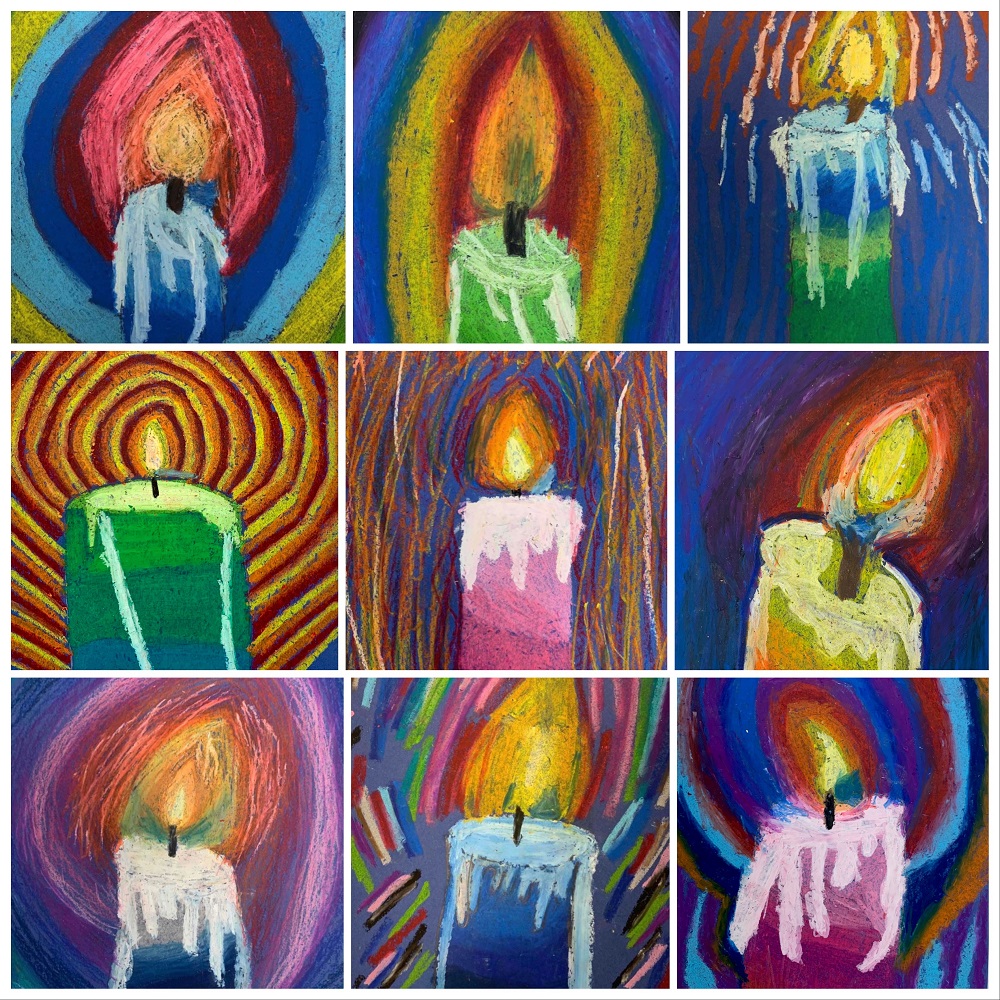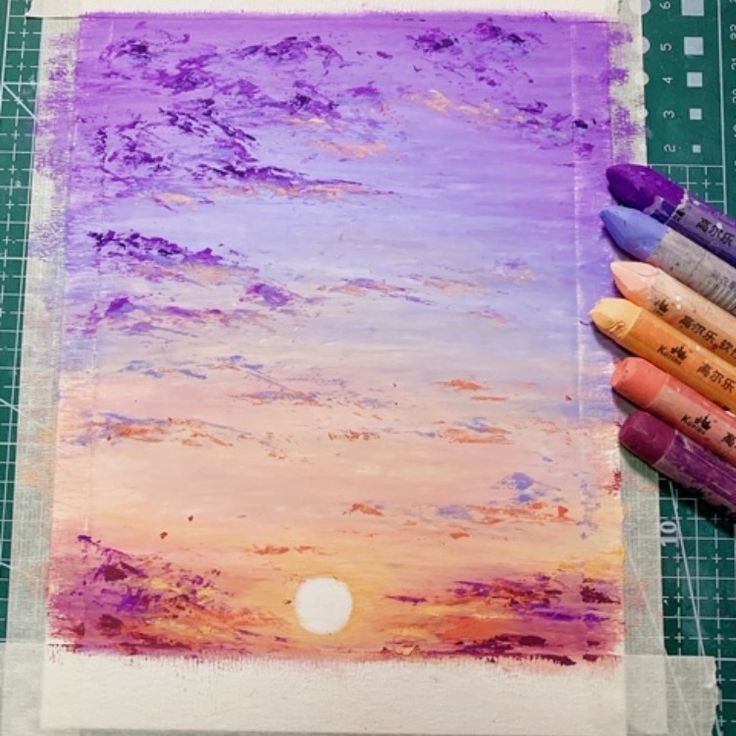Introduction to Oil Pastels
Oil pastels are a vibrant medium for creating stunning artwork. They blend easily and offer rich, pigmented colors. With their unique texture, they bridge the gap between drawing and painting. Beginners and seasoned artists alike can enjoy the flexibility and spontaneous nature of things to draw with oil pastels.
For those new to oil pastels, understanding their properties is essential. They’re much softer than traditional crayons or hard pastels. Their creaminess allows for tactile art-making. This means you can use your fingers to blend colors directly on paper.
Why choose oil pastels? They are incredibly versatile. Create bold, expressive strokes or subtle gradients. With oil pastels, you can draw on a range of surfaces. Try paper, canvas, or even wood. And unlike oil paints, there’s no need for brushes or solvents.
Oil pastels are great for experimentation. What’s more, they’re portable. Take them outdoors and sketch directly from nature. Or, use them indoors for still-life drawings and portraits.
Diving into oil pastel art offers endless possibilities. From serene landscapes to vibrant abstracts, you can express your vision. Let’s explore how to unlock your inner artist with oil pastels. We’ll look at simple techniques, subjects to draw, and how different paper types can enhance your work.
Essential Oil Pastel Techniques for Beginners
Mastering oil pastels requires practice and knowing a few key techniques. Here are essential tips for beginners.
Start with Simple Strokes
Begin with basic strokes like lines, dots, and dashes. Practice makes perfect. Start with these to build control and confidence.
Layer Colors
Layering is vital in oil pastel drawing. Start with a light base, then add darker shades on top. This builds depth and texture.
Blending for Smooth Transitions
Use your fingers or a blending stump to merge colors. Smooth transitions give your work a more professional finish. Blend lightly at first, then increase pressure as needed.
Create Highlights and Shadows
Oil pastels are opaque, which makes adding highlights and shadows easy. Use lighter shades for highlights and darker tones for depth.

Scumbling for Texture
Scumble by lightly layering colors without completely blending. It adds interesting textures to your drawing.
Sgraffito for Details
Sgraffito means scratching the surface. Lay down a dark color, then scratch with a pointed tool to reveal the layer below.
Experiment with Solvents
For a painterly effect, dilute oil pastels with turpentine or baby oil. Apply with a brush for glazes or washes. Note, some oil pastels are water-soluble for easy dilution.
Use Protective Fixative
Finish your artwork with a fixative spray. It protects your piece from smudging and dust.
Remember, practice these techniques regularly. Experiment to find your style. Have fun creating amazing art with oil pastels.
Still Life Drawings with Oil Pastels
Drawing still life is a classic art project. With oil pastels, it becomes more vibrant. Here’s how you can create a still life drawing using oil pastels.
Start with an Arrangement
Choose objects with different shapes and textures. A vase, fruit, or book can work well.
Sketch Your Composition
Begin by outlining your objects lightly. Don’t press too hard, as you’ll add layers later.
Block in Basic Colors
Fill the shapes with flat colors. Think about the light source as you pick your shades.
Add Shadows and Highlights
Darken areas away from light for shadows. Use light colors on areas the light hits.
Blend Your Colors
Use your finger or a blending tool. Blend edges where colors meet for a natural look.
Refine Details
Add sharp lines and textures last. Small strokes can show details like fruit skin.
Adjust and Fix
Review your drawing. Make changes if needed. Spray with a fixative to prevent smudging.
Drawing with oil pastels offers a different experience from traditional painting. The colors are bright and blend easily. Even simple items can look stunning. Try to practice often and experiment with different subjects for your still life drawings.

Animal-Inspired Oil Pastel Artwork
Creating animal-inspired artwork with oil pastels can bring a sense of life and energy to your drawings. Whether realistic or stylized, animal subjects offer a variety of textures, patterns, and colors to explore. Here’s how you can get started on your zoological art journey.
Start with Your Favorite Animal
Select an animal that fascinates you. It could be a pet or a wild creature.
Sketch the Basic Outline
Draw the animal lightly, focusing on its essential shapes and posture.
Apply Base Colors
Choose colors that match the animal’s coat or skin. Fill in the outline.
Texturize Fur or Feathers
Layer multiple colors to mimic fur or feather textures.
Add Shadows for Depth
Use darker shades along the body where shadows naturally occur.
Highlight for Realism
Dab on lighter colors to reflect where light hits the animal’s form.
Refine and Detail
Make the final touches with small strokes to outline eyes, whiskers, or scales.
Preserve Your Work
Spray with a fixative to protect your animal-inspired oil pastel piece.
Drawing animals with oil pastels helps you practice blending techniques and color choices. Try different animals to challenge your skills. With each piece, you’ll feel your confidence grow and your portfolio expand.
Capturing Nature: Landscape and Seascape Ideas
Drawing with oil pastels allows you to capture the beauty of nature. Landscapes and seascapes are perfect subjects for oil pastel art. They offer a variety of colors, shapes, and textures. Here are some ideas for creating nature-inspired oil pastel drawings.
Choose a Scene That Sparks Joy
Pick a landscape or seascape that speaks to you. It can be a mountain range, a forest scene, or a coastal view. Make sure the scene has elements that excite you.
Start with the Sky
The sky sets the mood for your piece. Use blues, purples, and oranges to reflect different times of day. Blend these colors to make a smooth transition.
Add the Land or Water
For landscapes, use greens and browns to show grass and earth. For seascapes, blues and greens will mimic the water’s colors. Blend for a natural look.
Use Short Strokes for Texture
Short strokes can create the texture of leaves and waves. Layer these strokes to add depth to your drawing.
Balance Light and Dark
Add light colors to areas hit by sunlight. Use dark colors for shadows. This contrast will give your drawing more life.
Refine Details Last
Fine-tune your drawing with small details. This will pull your whole scene together. Don’t rush this step.
Protect Your Artwork
Once happy with your drawing, spray it with fixative. This will keep it from smudging.
Landscapes and seascapes in oil pastels bring nature’s serenity into your art. Each drawing can be a peaceful escape or a vibrant exploration. Remember to practice and experiment. Enjoy the process of capturing the world around you.

Exploring Abstract Oil Pastel Creations
Exploring abstract art with oil pastels is exciting. It can be freeing as there are no rules to how abstract art should look. Here are some ideas to get you started.
Embrace the Freedom of Abstraction
Abstract art lets you express feelings and ideas without realistic images. Start with colors that inspire you. Make bold strokes or gentle marks on the paper. Let your mood guide your hand.
Color Blocking to Convey Emotion
Choose a few colors to represent different emotions. Apply large blocks of these colors onto your paper. See how they interact and what story they tell together.
Dynamic Shapes and Lines
Use shapes and lines to create energy. Sharp angles can show tension. Curved lines can create calm. Combine different shapes to build a dynamic drawing.
Layering and Texturing
Overlay colors to create depth. Add textures with different pressure or tools. Scratch into layers to reveal colors underneath.
Experiment with Negative Space
Leave areas of your paper blank. This negative space can create powerful contrasts. It adds intrigue and balance to your creation.
Incorporate Mixed Media
Add other materials with your oil pastels. Try using pencil, ink, or even collage. These can add variety to your abstract pieces.
Abstract oil pastel creations offer endless possibilities. Play with colors, shapes, and textures. Break away from traditional scenes and draw what you feel inside. Make sure to practice often. And remember to have fun as you explore the abstract world with your oil pastels.
Urban Scenes: Cityscape and Architecture in Oil Pastels
Oil pastels bring urban scenes to life with vibrant energy. Cityscapes and architectural details shine under their bold hues.
Draw a Stunning Cityscape
Capture the hustle of city life with a few pastel strokes. Skyscrapers and streets bustle in multicolor. Start with your city’s silhouette. Layer pastel shades to reflect the sky at different times. Dusk? Use blues and purples. Morning? Warm oranges and yellows. Add buildings in various sizes. Use short strokes for distant lights, longer for nearby structures. Remember, the key is to keep your lines simple and colors vivid.
Architectural Wonders in Detail
Focus on a single building or architecture feature. Maybe it’s an old door or a modern facade. Use oil pastels to highlight textures. Brickwork comes alive with thoughtful color layering. Curved arches need smooth color transitions. Consider light play – where does sunlight hit? Where does shadow fall? Apply dark tones to deepen shadows. Use bright spots for sun-kissed areas. Each mark adds dimension and character to your piece.
With oil pastels, urban drawing is exciting and creative. Try mixing colors to mimic different materials. Concrete can have grays with blue undertones. Glass might reflect sky colors. Each drawing is your urban exploration on paper. Spray with a fixative to preserve your city-inspired artwork.
Using Oil Pastels on Different Types of Paper
Oil pastels are versatile, and paper choice can affect your results. Different types of paper bring out unique qualities in oil pastel art. Here’s how to use oil pastels with various paper types.
Consider the Weight of the Paper
Heavier papers can hold more layers of pastel without buckling. They are ideal for complex, textured pieces. Light-weight papers work for quick sketches or simpler artworks.
Texture Matters
Smooth paper lets you create fine details and solid color areas. Rougher textures are good for expressive work, adding depth and interest.
Color Your Canvas
Don’t limit yourself to white paper. Try pastels on colored paper to see how it changes tones and mood. Dark papers make colors pop, especially light and bright hues.
The Right Absorbency
Some papers absorb oil pastel better. This can help with blending and layering. Test how your pastels work on different papers to find the best match.
Watercolor Paper for Water-Soluble Pastels
If you’re using water-soluble oil pastels, watercolor paper is a must. It withstands water without warping, allowing for interesting wet effects.
By trying different papers with oil pastels, you expand your artistic options. Mix things up; you might find a new favorite method. Always remember to use a fixative to protect your work.